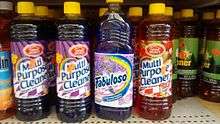Hard-surface cleaner
Hard surface cleaners is a category of cleaning agents comprising mainly aqueous solutions of specialty chemicals that vary with the amount of dirt and the surface being cleaned.[1]
All-purpose cleaners

All-purpose cleaners are usually concentrated solutions of surfactants and water softeners, which enhance the behavior of surfactant in hard water. Typical surfactants are alkylbenzenesulfonates, an anionic detergent, and modified fatty alcohols. A typical water softener is sodium triphosphate.
Glass cleaners
Light duty hard surface cleaners are not intended to handle heavy dirt and grease. Because these products are expected to clean without rinsing and result in a streak-free shine, they contain no salts. Typical window cleaning items consist of alcohols, either ethanol or isopropanol (rubbing alcohol) and surfactants for dissolving grease. Other components include small amounts of ammonia as well as dyes and perfumes.
These are composed of organic,water-miscible solvent such as isopropyl alcohol and an alkaline detergent.Some glass cleaners also contain a fine,mid abrasive.Most glass cleaners are available as sprays or liquid.They are sprayed directly onto windows,mirrors and other glass surfaces or applied on with a soft cloth and rubbed off using a soft,lint-free duster.A glass cloth ideal for the purpose & soft water to which some methylated spirit or vinegar is added which is an inexpensive glass cleaner.
Metal cleaners
For ferrous metals, the cleaners contain chelating agents, abrasives, and surfactants. These agents include citric and phosphoric acids, which are nonaggressive. Surfactants are usually modified fatty alcohols. Silver cleaning is a specialty since silver is noble but tends to tarnish via formation of black silver sulfide, which is removable via silver-specific complexants such as thiourea.
Building facade cleaners
For acid-resistant building facades, such as brick, acids are typically used. These include mixtures of phosphoric and hydrofluoric acids as well as surfactants. For acid-sensitive facades such as concrete, strongly alkaline cleaners are used such as sodium hydroxide and thickeners. Both types of cleaners require a rinsing and often special case since the solutions are aggressive toward skin.
Toilet bowl cleaners
Toilet bowl cleaning often is aimed at removal of calcium carbonate deposits, which are attacked by acids. Powdered cleaners contain acids that come in the form of solid salts, such as sodium hydrogen sulfate. Liquid toilet bowl cleaners contain other acids, typically dilute hydrochloric, phosphoric, or formic acids. These convert the calcium carbonate into salts that are soluble in water or are easily rinsed away.
Scouring agents
Scouring agents are mixtures of the usual cleaning chemicials (surfactants, water softeners) as well as abrasive powders. The abrasive powder must be of a uniform particle size. Bleaching powders contain compounds that release sodium hypochlorite, the classical household bleaching agent. These precursor agents include trichloroisocyanuric acid and mixtures of sodium hypochlorite (“chlorinated orthophosphate”).
References
- ↑ Christian Nitsch, Hans-Joachim Heitland, Horst Marsen, Hans-Joachim Schlüussler, "Cleansing Agents" in Ullmann’s Encyclopedia of Industrial Chemistry 2005, Wiley-VCH, Weinheim. doi:10.1002/14356007.a07_137